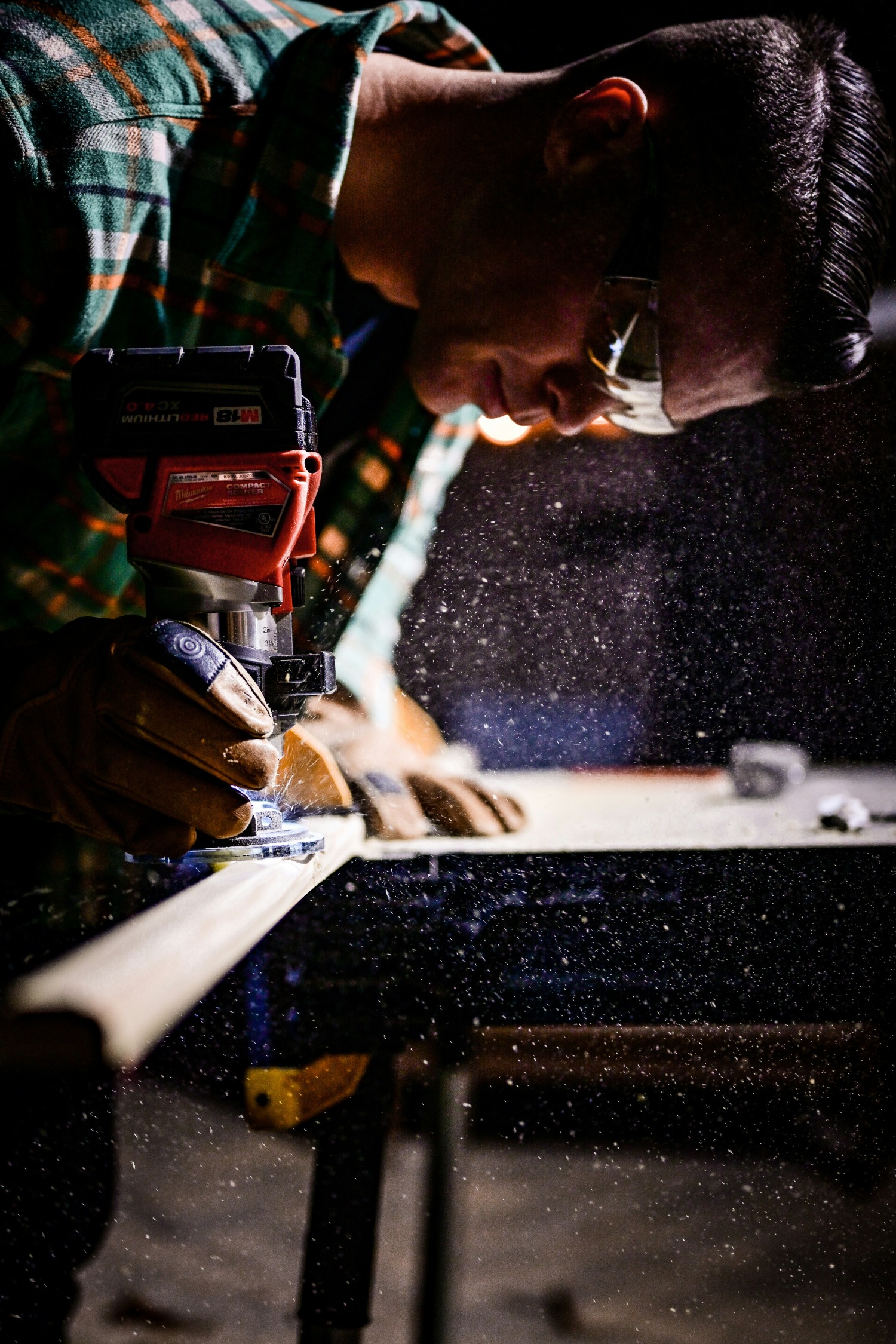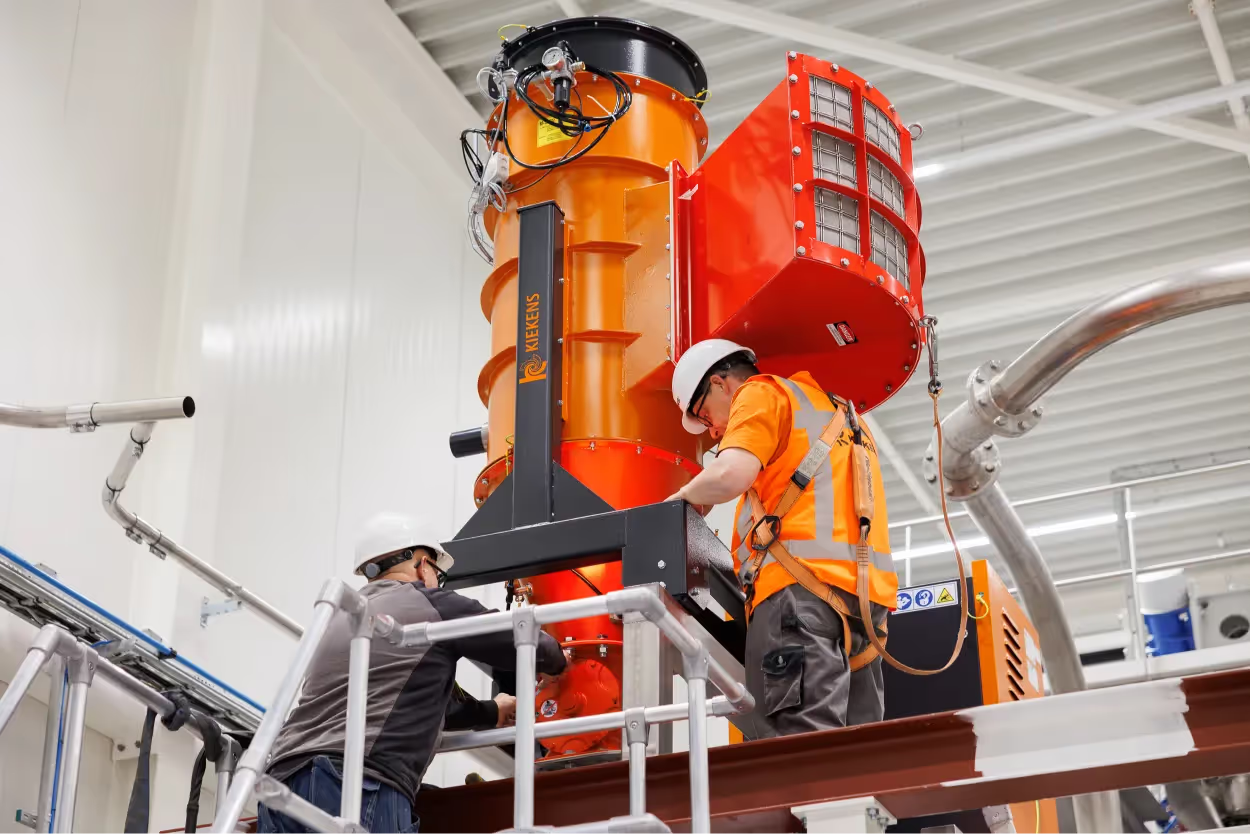Dust extraction in industrial workspaces

Why an extractor in an industrial workspace?
Sanding, sawing, face milling or milling in the workshop quickly releases a lot of dust, sawdust or aerosols. Without technical measures, it ends up in the air and is inhaled unhindered — with sometimes serious consequences. In the worst case, fires can be caused by flammable dust or emissions can cause damage to the machines used. A professional extraction system helps: an extraction system extracts these airborne substances directly at the source. This significantly improves air quality and thus supports compliance with legal regulations and, in particular, increases workplace safety.
What are the dangers of dust in an industrial workspace?
The dust released during the processing of wood, metal or plastic is more than just dirt: it is a potential health risk. Particulate matter, in particular, penetrates deep into the lungs and can cause inflammation, respiratory diseases or even cancer. The explosion risk with flammable substances such as aluminum or softwood is also serious: without suitable dust extraction, a dangerous reaction can occur at certain concentrations. Especially in a small, poorly ventilated industrial workspace.
Thoughtful extraction in the industrial workspace therefore reduces:
- respiratory diseases
- absenteeism and absenteeism
- allergies due to wood, plastic or metal dust
- risk of dust explosions
- wear and tear of machines due to deposited sawdust, etc.
Legal frameworks such as the Working Conditions Act, the Working Conditions Decree and industry-specific guidelines set clear requirements for improving air quality in industrial environments — regardless of the size of the company.
Kiekens extraction systems — Where quality meets performance
At Kiekens, the safety of your workplace comes first. That's why we have an extensive portfolio of extraction systems for every industrial workspacesize that guarantee use. Whether it's a hobby workshop, an industrial company or specialized woodworking machines — Kiekens' installations impress with:
- high suction power
- energy efficiency
- robust materials
- sustainable filter technology
- low maintenance costs
These products you will find:
- Mobile extraction systems: flexible, compact, can be deployed quickly where necessary.
- Stationary extraction systems: central capacity for multiple workplaces, strong in continuous operation, high capacity.
- ATEX certified installation: explosion-proof, suitable for metal dust.
- Accessories: from suction hose to spare part; everything in stock and can be combined.
Mobile vs. stationary extraction - Which solution fits?
When choosing the right extraction technology, the question often comes up: a mobile or a stationary extraction system? Both variants have a right to exist and work differently depending on the area of application, industrial workspace size, the machines used and the desired level of automation.
Mobile extraction systems
These can be used flexibly and can be positioned directly at various workplaces. Very practical when individual machines such as sanders, milling machines or saws are used independently in the industrial workspaces. Thanks to wheels or compact construction, these devices are easy to move. This makes them ideal for changing processing stations or temporary use.
An additional advantage: the purchase costs are relatively low and, thanks to targeted use, dust extraction is still very effective. Mobile extraction systems have proven themselves, especially in hobby workshops or smaller companies with limited space.
Stationary extraction systems
Stationary systems, on the other hand, offer a permanent, powerful solution, especially suitable for larger workshops or industrial production environments. They can be installed centrally and connected to multiple machines at the same time via a network of pipes, extraction arms and valves. This keeps the airflow consistent and the dust extraction at all connected workstations remains optimal.
These systems are usually more energy efficient, quieter and less maintenance in continuous operation. They can be equipped with automatic controls and intelligent filter systems, so that the suction power can be dynamically adjusted to use — a decisive advantage for continuous production work.
Tip for combining both systems
In practice, it often appears: a combination of central, stationary extraction and mobile supplementary equipment is particularly strong. For example, permanently installed sanding areas can be continuously extracted, while mobile devices are temporarily used where additional dust production takes place — for example during conversions, special orders or point-specific sanding processes.
Whether mobile or stationary: Kiekens provides customized solutions for every application, focusing on one goal: clean air, safe working conditions and maximum flexibility.
Appropriate extraction for every application
Depending on the material and the processing, you need different systems. Here are a few examples with the corresponding solution:
Setting up an extraction system — Components & functions
A powerful extraction system consists of well-coordinated components. The process starts with the extraction nozzle or a specially designed hood, which picks up the dust directly at the source. The medium is led to the central unit via a flexible suction hose. Here, a radial fan or powerful engine provides the necessary negative pressure, so that the emissions are pulled through the system. The filters then take action: depending on the type of dust, they effectively stop even the smallest particles or harmful substances and prevent health-harmful substances from entering the air.
The collected particles are eventually collected in a dust or sawdust container or a chip bag, which must be emptied or replaced regularly. For continued good performance, the installation should be cleaned regularly and the filters replaced in time. This is the only way to ensure that the installation remains suction powerful, reliable and the desired results are achieved.
Criteria and planning for the right extraction system
Technical criteria when selecting an extraction system
These points should be paid attention to when selecting:
- Suction capacity (m³/h): the volume flow must be appropriate to the type of machine and the amount of dust or sawdust that is released. Too little air capacity = insufficient extraction; too much = unnecessary energy consumption.
- Filter class: Depending on the type of dust, an appropriate filter system with HEPA filters, pleated filters or activated carbon is required.
- Hose diameter and tube length: the inner diameter and length of pipes influence flow velocity and pressure loss — the shorter and straighter, the more efficient.
- Noise level: Low noise levels are important, especially in small workshops. Modern installations combine high performance with low noise pollution.
- Energy consumption: an energy-efficient installation reduces long-term operating costs.
- Controls: The control can be manual, sensor-controlled or fully automatic, depending on user comfort and application. Automatic systems control airflow and filter monitoring efficiently and with little maintenance.
Planning and configuring your extraction solution
Kiekens carefully plans each extraction system according to local conditions — customized, not standard. Among other things, we look at:
- the number and type of machines that are used simultaneously or alternately.
- the nature and amount of dust that is released, for example fine sanding dust, coarse sawdust or potentially explosive metal dust.
- the requirements for the filter, dust or sawdust container and shut-off valves, depending on particle size, air volume flow and maintenance intervals.
- piping systems that can run through the wall, ceiling or floor, depending on the room.
- future expandability to respond flexibly to new machines, materials or workplaces.
What distinguishes Kiekens from other suppliers?
For over 100 years, Kiekens has been the partner for reliable extraction technology in workshops and industrial environments. Our systems are robustly built, energy efficient and equipped with low-maintenance filters and ATEX certification where necessary. What sets us apart? Each installation is fully customized and tailored to your space, processes and technical requirements. And we do that not only with technology, but also with personal service: from advice and design to installation and maintenance, at Kiekens, you get everything under one roof — professional, practical and involved.
Because dust pollutes the dair, damages machines and threatens the health of employees. An extraction system works as a “vacuum cleaner” for emissions and offers effective protection against all these risks.
Mobile extraction units with a sawdust or dust filter bag are perfect for confined spaces and occasional use. In addition, they are easy to use and can be used flexibly.
Depending on the load, the installation should be checked at least annually (better: biannually). Filter change and visual inspection of components are essential.
Yes. With stationary systems, central control, shut-off valves and suitable pipelines, this is easily possible. Especially useful for larger companies or one large workspace.
Regular maintenance is essential to maintain the suction power, filter effect and safety of your extraction system. Contaminated filters or clogged pipes can not only reduce performance, but also lead to downtime or limit values being exceeded. With the Clean Air Plan van Kiekens takes care of this maintenance: we monitor, inspect and optimize your system periodically - so that you are always assured of clean air, maximum efficiency and compliance with laws and regulations.




